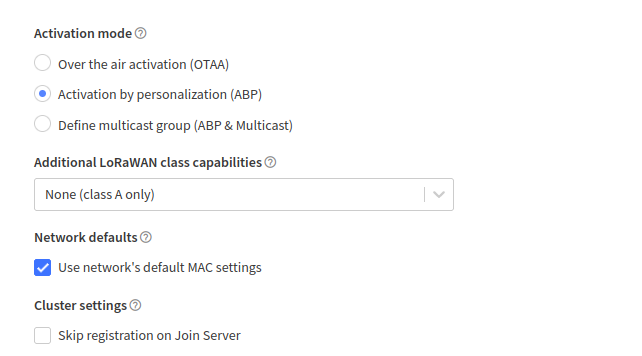Summary
Hello!
I’m currently to send data to a TTSS application trough ABP activation.
Currently is not possible for me to do an OTAA activation for reasons that are currently being solved, eventually, it will, but in the meantime, I really need to send basic information from 1 end-device to run some basics test.
Sadly, when I try to connect trough ABP I see the data on the gateway (on TTSS), but I don’t see nothing on the end-device tab, even if I activate the verbose stream, there’s nothing at all.
I’m sure that I’m inputting the following data correctly:
- devaddr
- NWKS_KEY
- APPS_KEY
The current configurations are as follows:
General information
- Frequency plan: Europe 863-870 MHz (SF9 for RX2 - recommended)
- LoRaWAN version: LoRaWAN Specification 1.0.4
- Regional Parameters version: RP002 Regional Parameters 1.0.3
Information regarding the ABP connection

Logs
The received packet in the gateway tab (just the information that should be relevant):
{
"name": "gs.up.receive",
"time": "2024-05-29T08:31:22.842547298Z",
"identifiers": [
{
"gateway_ids": {
"gateway_id": --------------,
"eui": "7276FF002E090355"
}
}
],
"data": {
"@type": "type.googleapis.com/ttn.lorawan.v3.GatewayUplinkMessage",
"message": {
"raw_payload": "QEAwIBAAAgAKjTyF/KxL3ItFqVBLyRo=",
"payload": {
"m_hdr": {
"m_type": "UNCONFIRMED_UP"
},
"mic": "UEvJGg==",
"mac_payload": {
"f_hdr": {
"dev_addr": "10203040",
"f_ctrl": {},
"f_cnt": 2
},
"f_port": 10,
"frm_payload": "jTyF/KxL3ItFqQ=="
}
},
"settings": {
"data_rate": {
"lora": {
"bandwidth": 125000,
"spreading_factor": 12,
"coding_rate": "4/5"
}
},
"frequency": "866100000",
"timestamp": 2740349556
},
"rx_metadata": [
{
"gateway_ids": {
"gateway_id": "eui-7276ff002e090355",
"eui": "7276FF002E090355"
},
"timestamp": 2740349556,
"rssi": -117,
"signal_rssi": -129,
"channel_rssi": -117,
"snr": -12,
"frequency_offset": "417",
"location": {
"latitude": 45.7862056,
"longitude": 4.87972983,
"altitude": 20,
"source": "SOURCE_REGISTRY"
},
"uplink_token": "CiIKIAoUZXVpLTcyNzZmZjAwMmUwOTAzNTUSCHJ2/wAuCQNVEPTU2ZoKGgwI2s/bsgYQk8HukAMgoKq/zODmIg==",
"channel_index": 6,
"received_at": "2024-05-29T08:31:22.840671379Z"
}
],
"received_at": "2024-05-29T08:31:22.840671379Z",
"correlation_ids": [
"gs:uplink:01HZ1QKBPTPNV7HN86R802S1A8"
],
"crc_status": true
},
"band_id": "EU_863_870"
},
"correlation_ids": [
"gs:uplink:01HZ1QKBPTPNV7HN86R802S1A8"
],
"origin": "ip-10-100-6-18.eu-west-1.compute.internal",
"context": {
"tenant-id": "CgN0dG4="
},
"visibility": {
"rights": [
"RIGHT_GATEWAY_TRAFFIC_READ"
]
},
"unique_id": --------------------
}
Hardware
I’m using a LR1110 DevKit
My question
Why I don’t see any data at all in the end-device tab?
What should I do to start receiving data on the application server?